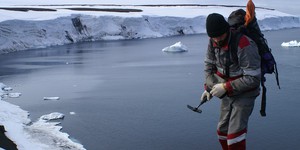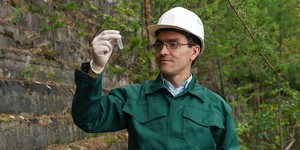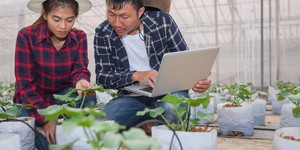Log In
Summary
*Note:
For this science project you will need to develop your own experimental procedure. Use the information in the summary tab as a starting place. If you would like to discuss your ideas or need help troubleshooting, use the Ask An Expert forum. Our Experts won't do the work for you, but they will make suggestions and offer guidance if you come to them with specific questions.
If you want a Project Idea with full instructions, please pick one without an asterisk (*) at the end of the title.
If you want a Project Idea with full instructions, please pick one without an asterisk (*) at the end of the title.
Abstract
Think about mountain ranges, canyons, sand dunes, or any other interesting geological feature you may live near enough to visit. The surface of the Earth is always changing due to a balance of forces both above and below the surface. Below-surface forces cause the Earth's crust to be faulted, folded, tilted, and lifted. Above-surface forces are primarily due to the natural processes of weathering and erosion. Can you show the effects of these forces using scale models, demonstrations, computational models, maps or geological databases? How do forces both above and below the surface create geological features? What is the difference between weathering and erosion? What is the difference between features that form due to natural processes of erosion and environmentally destructive processes of erosion? Are there factors that can help control erosion, like soil structure, vegetation or slope? Once rock has been broken up by weathering the small pieces can be moved by water, ice, wind, or gravity. Is the way a river changes a landscape different for slow and rapidly flowing rivers? How do glaciers change the landscape? How does gravity contribute to rock slides?Ask an Expert
Do you have specific questions about your science project? Our team of volunteer scientists can help. Our Experts won't do the work for you, but they will make suggestions, offer guidance, and help you troubleshoot.
Global Connections
The United Nations Sustainable Development Goals (UNSDGs) are a blueprint to achieve a better and more sustainable future for all.
This project explores topics key to Sustainable Cities and Communities: Make cities inclusive, safe, resilient and sustainable.
Careers
If you like this project, you might enjoy exploring these related careers:
Career Profile
Just as a doctor uses tools and techniques, like X-rays and stethoscopes, to look inside the human body, geoscientists explore deep inside a much bigger patient—planet Earth. Geoscientists seek to better understand our planet, and to discover natural resources, like water, minerals, and petroleum oil, which are used in everything from shoes, fabrics, roads, roofs, and lotions to fertilizers, food packaging, ink, and CD's. The work of geoscientists affects everyone and everything.
Read more
Career Profile
Not all dirt is created equal. In fact, different types of soil can make a big difference in some very important areas of our society. A building constructed on sandy soil might collapse during an earthquake, and crops planted in soil that doesn't drain properly might become waterlogged and rot after a rainstorm. It is the job of a soil scientist to evaluate soil conditions and help farmers, builders, and environmentalists decide how best to take advantage of local soils.
Read more
Career Profile
Hydrologists examine the physical characteristics, distribution, and circulation of water above and below the earth's surface. They study rainfall and other precipitation, the paths precipitation takes through the soil and rocks underground, and its return to the oceans and air. Often, they specialize in either underground water or surface water. They examine the form and intensity of precipitation, its rate of infiltration into the soil, its movement through the Earth, and its return to the…
Read more
Career Profile
Soil and water are two of Earth's most important natural resources. Earth would not be able to sustain life without nutritive soil to grow food and clean water to drink. Soil and water conservationists foster the science and art of natural resource conservation. The scientists work to discover, develop, implement, and constantly improve ways to use land that sustains its productive capacity, and enhances the environment at the same time. Soil and water conservationists are involved in improving…
Read more
Related Links
Cite This Page
General citation information is provided here. Be sure to check the formatting, including capitalization, for the method you are using and update your citation, as needed.MLA Style
Science Buddies Staff.
"Earth Surface Dynamics." Science Buddies,
20 Nov. 2020,
https://www.sciencebuddies.org/science-fair-projects/project-ideas/Geo_p032/geology/earth-surface-dynamics?class=AQV_vsRwjrY5Go2gOEpU_eYovKEbYRt4TBVrwdQ-wHBgkMnWBWwtIe_uDMCQIzE9St4yqn5rLP4ZiPIGyG_vX2z9ywUchl72N6WLU_G2pniBrA.
Accessed 23 Apr. 2024.
APA Style
Science Buddies Staff.
(2020, November 20).
Earth Surface Dynamics.
Retrieved from
https://www.sciencebuddies.org/science-fair-projects/project-ideas/Geo_p032/geology/earth-surface-dynamics?class=AQV_vsRwjrY5Go2gOEpU_eYovKEbYRt4TBVrwdQ-wHBgkMnWBWwtIe_uDMCQIzE9St4yqn5rLP4ZiPIGyG_vX2z9ywUchl72N6WLU_G2pniBrA
Last edit date: 2020-11-20
Explore Our Science Videos
DIY Mini Drone Part 2: Altitude Control Circuit
DIY Light Up Unicorn Headband
Why Won't it Mix? Discover the Brazil Nut Effect











